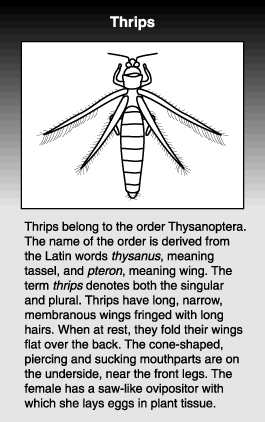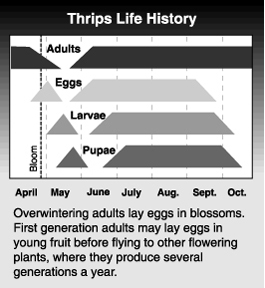by Irene Terry, Elizabeth H. Beers, and S. Cockfield, originally published 1993; revised December 2007
Frankliniella occidentalis (Pergande) (Thysanoptera: Thripidae)
 Thrips are small, slender insects, with four long, narrow wings fringed with hairs. The western flower thrip is widely distributed throughout the United States. It feeds on a number of plants and occasionally damages tree fruit. Thrips rasp the surface of the fruit as they feed, and their feeding weakens flowers and fruit stems. Females puncture the fruit with their serrated ovipositors to lay eggs in the tissue.
Thrips are small, slender insects, with four long, narrow wings fringed with hairs. The western flower thrip is widely distributed throughout the United States. It feeds on a number of plants and occasionally damages tree fruit. Thrips rasp the surface of the fruit as they feed, and their feeding weakens flowers and fruit stems. Females puncture the fruit with their serrated ovipositors to lay eggs in the tissue.
Damage does not occur every year and is difficult to predict. Thrips visit many other flowering plants as well as tree fruits, and if those plants are in bloom at the same time the thrips population will be diluted and there will be less chance of fruit damage.
Hosts
Western flower thrips feeds on apple, apricot, peach, plum, nectarine, orange, lemon, alfalfa, potato and numerous weed species.
Life stages
Egg
The egg is cylindrical and slightly kidney shaped. The female makes an incision into the leaf, stem or fruit of plants with her serrated ovipositor and deposits a single egg. The egg is embedded and protected within the plant tissue.
Larva
The young thrip resembles the adult but is smaller. The first two instars are wingless and are called larvae. They feed on nectar, pollen and plant tissue, as do adults. The third instar, called the prepupa, is inactive, does not feed and has wing buds.
Pupa
The pupa, the fourth instar, is also a resting, nonfeeding stage.
Adult
The adult is about 1/25 inch (1 mm) long. It is slender, with four narrow wings fringed with hairs folded flat over the back. It is yellow with dusky markings on the side of the abdomen. The two sexes look similar, but the male is smaller and always light colored. The abdomen of females ranges from pale yellow to dark brown.
Life history
 Thrips have multiple, overlapping generations on a broad range of plant species. Thrips overwinter as adults in protected places on the ground. When they emerge in the spring they seek out flowering plants. On fruit trees, they enter blossoms at the full pink stage and feed on flower parts. Females lay eggs in the pistils, stamens and receptacles of the blossoms. Larvae that hatch from the eggs feed within the calyx end of the young fruit. They feed by rasping the fruit surface with their mouth parts and sucking the liquid. When mature, 7 to 14 days after petal fall, they drop to the ground and pass an inactive stage under dead leaves near host plants before molting into adults. New adults may lay eggs in the young fruit before flying to other flowering plants. A low level of thrips occurs on vegetative tissues of apple during the post-bloom period, but in general this species follows and utilizes blooming plants.
Thrips have multiple, overlapping generations on a broad range of plant species. Thrips overwinter as adults in protected places on the ground. When they emerge in the spring they seek out flowering plants. On fruit trees, they enter blossoms at the full pink stage and feed on flower parts. Females lay eggs in the pistils, stamens and receptacles of the blossoms. Larvae that hatch from the eggs feed within the calyx end of the young fruit. They feed by rasping the fruit surface with their mouth parts and sucking the liquid. When mature, 7 to 14 days after petal fall, they drop to the ground and pass an inactive stage under dead leaves near host plants before molting into adults. New adults may lay eggs in the young fruit before flying to other flowering plants. A low level of thrips occurs on vegetative tissues of apple during the post-bloom period, but in general this species follows and utilizes blooming plants.
Damage
 Pre-bloom feeding deforms blossoms and leaves, reducing fruit set or weakening the fruit so it is more susceptible to frost and temperature stresses. Thrips also spoil fruit finish by rasping the surface while feeding and by puncturing the fruit while laying eggs.
Pre-bloom feeding deforms blossoms and leaves, reducing fruit set or weakening the fruit so it is more susceptible to frost and temperature stresses. Thrips also spoil fruit finish by rasping the surface while feeding and by puncturing the fruit while laying eggs.
Feeding damage is usually more severe on stone fruits than on apples. On stone fruits, feeding causes scars similar to frost injury. On apples, feeding damage is usually only one cell deep on the fruit. When the fruit is damaged early in the season, it is russeted at harvest.
The major damage on apples is due to egg-laying punctures that cause a condition called pansy spot, a whitish discolored area shaped like the petals of a pansy surrounding a small scar where the egg was laid. On dark red apples, the pansy spot is usually covered with color at harvest, but yellow, pink and green varieties will still be discolored at harvest.
Monitoring
Thrips can easily be monitored by shaking a pink bud or flower cluster into a white plastic cup. Flick the cluster vigorously to ensure that most thrips are dislodged. Adults are easy to detect without magnification, but larvae are light colored and difficult to see. Larvae may be confused with small adult males, but they do not fly when disturbed.
Sample 5 or 6 clusters per tree and 5 or 6 trees per 10-acre block. Monitor border trees also, as thrips may move into the orchard from wild host plants. Sample in the morning, preferably at the same time of day, as thrips densities can change dramatically throughout the day if the weather is warm and calm, which is when they tend to fly.
The correlation between thrip densities and egg-laying damage is poor. However, if there are more than 1 to 2 adult females per cluster in apple, there is a risk of fruit damage due to egg laying. Feeding damage may occur at different densities. It tends to be more severe on soft fruits than on apples.
Biological control
Important predators include adults and nymphs of the minute pirate bug, Orius tristicolor, and larvae of green lacewings and predaceous thrips. These will attack thrips late in the growing season and prevent populations from increasing.
Management
Recent evidence in central Washington indicates although thrips adults are abundant during bloom, the best timing for sprays is later. Ovipositon in fruitlets (as opposed to other flower parts) starts to increase about petal fall to 5 mm fruit size. Sprays should applied just prior to this increase in oviposition to avoid damage. Delaying applications until after bee hives are removed from the orchard will both reduce potential hazards to pollinators, and broaden the range of insecticide choices.



